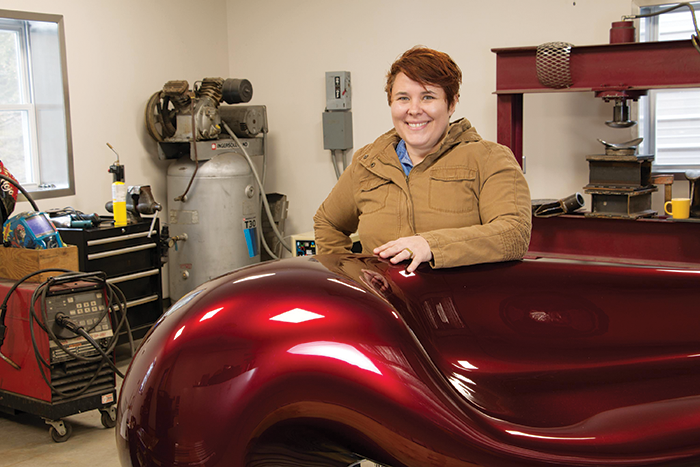Studio Visit: Vivian Beer
To get to sculptor/furniture designer Vivian Beer’s new home studio in Pembroke, New Hampshire, you follow a spooling industrial side road off the interstate past squat commercial lots with signs like NCR, eXCOM and Lou’s Custom Exhaust.
At the turnoff, past a no-frills Baptist church and a heavy equipment distributor, the landscape plunges into unexpected pines, hardwoods and the rustic Soucook River. That river also rounds the property: a two-story, four-bedroom house, two-car garage and the small aluminum frame of an outbuilding-in-progress. The only noticeable clue you’ve arrived at an art studio is, leaning against the garage, a stack of six-foot, inch-thick sheet-metal slabs, precision-cut with whimsical curves.
Half a year into first-home ownership, Beer is renovating and building out her new digs along with her wife, Mariana Rosas Garcia, and a small, prima-donna parrot known as Carmen Black-Friday Chica Chica Boom. “We’re in this weird zone,” Beer says, standing on an outside deck surrounded by trees, river and many adjoining acres of state conservation land protecting the city of Concord’s watershed. “It’s so peaceful, and yet it’s an industrial zone. Concord is five minutes away.” Similar contrasts vitalize Beer’s art as well as her process.
“Muscle cars and cosmetics have a lot in common,” she says, and you can see the truth of that immediately in Anchored Candy, the ongoing series of glistening, gummy-like furniture-sculptures she began making in 2009. (Examples can be seen in the permanent collections of Manchester’s Currier Museum and the Museum of Fine Arts, Boston.) Finished with automotive paint, clear coat and buffed to a dazzle, they at once suggest furniture (which they are), the human body, industrial architecture, high-heeled shoes and babied 1970s Corvettes. Classic cars and eye-shadow, she says, both “combine physical beauty and functional efficiency, the emotional and the physical, the performed female.” At 5’3″, Beer says she cut a conspicuous figure in the once male-dominated world of metalwork (things are changing now), yet has always felt as comfortable at an art opening as on a machine shop floor.
These sleek, abstracted metal benches, tables and chairs can seem like perfectly seamless objects designed and manufactured by computers in a parallel universe. In fact, in another contrast, they start as small hand-hewn models that are then digitally scanned and uploaded for the sake of manipulation and refinement (design software, she says, is primarily “a really awesome tape measure”). The objects take three-dimensional shape as full-size plywood models that she recreates in precision-cut steel that’s hammered, bent on an anvil, curved on an English wheel, welded, sandblasted, painted etc., all by her and by hand. The results, subtly embedded with complex gender dynamics, blur the line between sculpture and furniture and how we interact with each.
All of this requires not just space but different kinds of spaces, so that metal dust from a Computer Numerical Control (CNC) plasma metal-cutting unit isn’t messing with laptops and scanners. Elsewhere, areas where Beer is working with red-hot metals and heavy machinery must be outfitted, electrified and ventilated to industry specs. The property’s converted garage houses the main fabrication area, containing generators, hydraulic press, air compressors, a handheld plasma cutter, a hydraulic tubing bender, thousands of grinders, a palette-jack full of mortar and Quikcrete and a precision TIG welder from Lincoln Electric (Beer’s career is at the stage where equipment manufacturers court her for sponsorship.)
The main house’s finished basement accommodates a comfortable digital design studio, and the outbuilding under construction will house an 11′ x 16′ CNC plasma machine.
Beer and Garcia dream of building out the garage another few thousand feet and someday soon inviting other artists, designers and metalsmiths to stay and teach, with everybody kayaking in the river and overrunning the place. “It’s really beautiful in the summer,” insists Garcia. “The vision is for lots of people hanging out,” Beer concurs.
Although she’s building a new home base in the New Hampshire woods, she’s in love with the desert and getting into working with glass. With her restless energy and penchant for “always swimming upstream,” it’s anybody’s guess how long it’ll be before she, Mariana and Carmen Black-Friday Chica Chica Boom decide it’s time to shake things up again.
Christopher Volpe is a New Hampshire-based
artist and teacher.
Vivian Beer, vivianbeer.com

